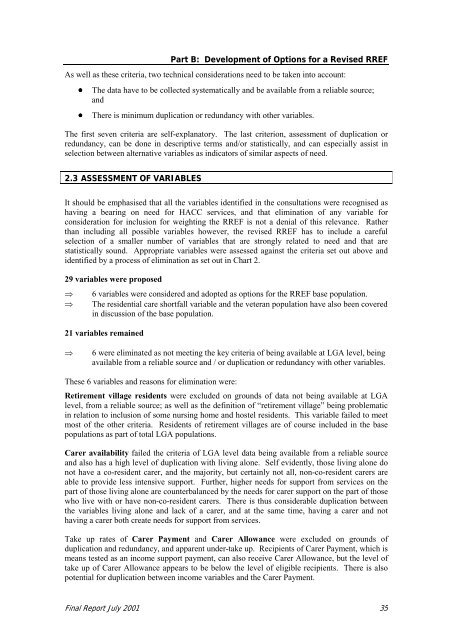Final Report on RREF 2001 - Department of Health
Final Report on RREF 2001 - Department of Health
Final Report on RREF 2001 - Department of Health
Create successful ePaper yourself
Turn your PDF publications into a flip-book with our unique Google optimized e-Paper software.
Part B: Development <strong>of</strong> Opti<strong>on</strong>s for a Revised <strong>RREF</strong><br />
As well as these criteria, two technical c<strong>on</strong>siderati<strong>on</strong>s need to be taken into account:<br />
• The data have to be collected systematically and be available from a reliable source;<br />
and<br />
• There is minimum duplicati<strong>on</strong> or redundancy with other variables.<br />
The first seven criteria are self-explanatory. The last criteri<strong>on</strong>, assessment <strong>of</strong> duplicati<strong>on</strong> or<br />
redundancy, can be d<strong>on</strong>e in descriptive terms and/or statistically, and can especially assist in<br />
selecti<strong>on</strong> between alternative variables as indicators <strong>of</strong> similar aspects <strong>of</strong> need.<br />
2.3 ASSESSMENT OF VARIABLES<br />
It should be emphasised that all the variables identified in the c<strong>on</strong>sultati<strong>on</strong>s were recognised as<br />
having a bearing <strong>on</strong> need for HACC services, and that eliminati<strong>on</strong> <strong>of</strong> any variable for<br />
c<strong>on</strong>siderati<strong>on</strong> for inclusi<strong>on</strong> for weighting the <strong>RREF</strong> is not a denial <strong>of</strong> this relevance. Rather<br />
than including all possible variables however, the revised <strong>RREF</strong> has to include a careful<br />
selecti<strong>on</strong> <strong>of</strong> a smaller number <strong>of</strong> variables that are str<strong>on</strong>gly related to need and that are<br />
statistically sound. Appropriate variables were assessed against the criteria set out above and<br />
identified by a process <strong>of</strong> eliminati<strong>on</strong> as set out in Chart 2.<br />
29 variables were proposed<br />
⇒ 6 variables were c<strong>on</strong>sidered and adopted as opti<strong>on</strong>s for the <strong>RREF</strong> base populati<strong>on</strong>.<br />
⇒ The residential care shortfall variable and the veteran populati<strong>on</strong> have also been covered<br />
in discussi<strong>on</strong> <strong>of</strong> the base populati<strong>on</strong>.<br />
21 variables remained<br />
⇒<br />
6 were eliminated as not meeting the key criteria <strong>of</strong> being available at LGA level, being<br />
available from a reliable source and / or duplicati<strong>on</strong> or redundancy with other variables.<br />
These 6 variables and reas<strong>on</strong>s for eliminati<strong>on</strong> were:<br />
Retirement village residents were excluded <strong>on</strong> grounds <strong>of</strong> data not being available at LGA<br />
level, from a reliable source; as well as the definiti<strong>on</strong> <strong>of</strong> “retirement village” being problematic<br />
in relati<strong>on</strong> to inclusi<strong>on</strong> <strong>of</strong> some nursing home and hostel residents. This variable failed to meet<br />
most <strong>of</strong> the other criteria. Residents <strong>of</strong> retirement villages are <strong>of</strong> course included in the base<br />
populati<strong>on</strong>s as part <strong>of</strong> total LGA populati<strong>on</strong>s.<br />
Carer availability failed the criteria <strong>of</strong> LGA level data being available from a reliable source<br />
and also has a high level <strong>of</strong> duplicati<strong>on</strong> with living al<strong>on</strong>e. Self evidently, those living al<strong>on</strong>e do<br />
not have a co-resident carer, and the majority, but certainly not all, n<strong>on</strong>-co-resident carers are<br />
able to provide less intensive support. Further, higher needs for support from services <strong>on</strong> the<br />
part <strong>of</strong> those living al<strong>on</strong>e are counterbalanced by the needs for carer support <strong>on</strong> the part <strong>of</strong> those<br />
who live with or have n<strong>on</strong>-co-resident carers. There is thus c<strong>on</strong>siderable duplicati<strong>on</strong> between<br />
the variables living al<strong>on</strong>e and lack <strong>of</strong> a carer, and at the same time, having a carer and not<br />
having a carer both create needs for support from services.<br />
Take up rates <strong>of</strong> Carer Payment and Carer Allowance were excluded <strong>on</strong> grounds <strong>of</strong><br />
duplicati<strong>on</strong> and redundancy, and apparent under-take up. Recipients <strong>of</strong> Carer Payment, which is<br />
means tested as an income support payment, can also receive Carer Allowance, but the level <strong>of</strong><br />
take up <strong>of</strong> Carer Allowance appears to be below the level <strong>of</strong> eligible recipients. There is also<br />
potential for duplicati<strong>on</strong> between income variables and the Carer Payment.<br />
<str<strong>on</strong>g>Final</str<strong>on</strong>g> <str<strong>on</strong>g>Report</str<strong>on</strong>g> July <strong>2001</strong> 35
















